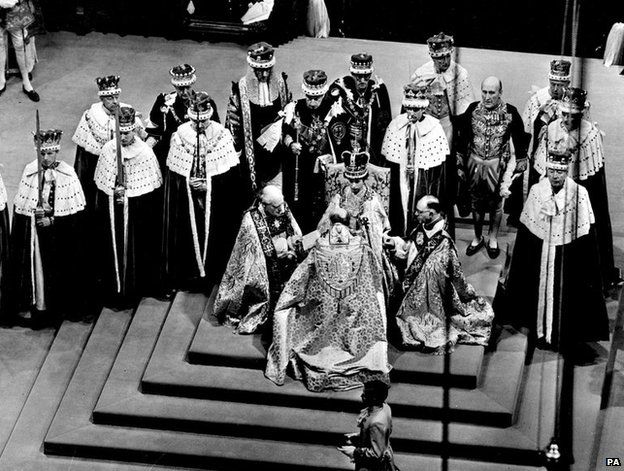Coronation 1953: Magic moment the TV cameras missed
- Published
- comments

Bishops pay homage to Queen Elizabeth II
The committee convened to organise the 1953 Coronation of Queen Elizabeth II took a full year to finalise the details amid argument as to how to maximise the impact of the event. One key question was whether the ceremony should be televised.
The Prime Minister Winston Churchill was reportedly horrified at the idea that "modern mechanical arrangements" - television cameras - should be used to broadcast from inside Westminster Abbey.
"It would be unfitting that the whole ceremony, not only in its secular but also in its religious and spiritual aspects, should be presented as if it were a theatrical performance," he told the House of Commons.
Perhaps Churchill recalled the arch-monarchist Walter Bagehot's advice: "We must not let in daylight upon magic." But the Queen and her advisors decided the cameras should be allowed to relay every moment of the meticulously planned ceremony - with one exception.
The television audience missed nothing of the pomp and pageantry, feathers and fur, golden spurs, jewel-encrusted orb, bracelets of sincerity and wisdom, ritual swords, anthems and trumpets. From the quiet of a choir softly singing "Come Holy Ghost, our souls inspire", to the shouts, bells and cannons that greeted the crowning moment, the spectacle didn't miss an emotional trick in trying to inspire the tens of millions crowded around small black-and-white TV sets.
The control room at Trafalgar Square broadcasting the event
But, in the middle of it all, a section of the service was conducted in secrecy.
The Act of Consecration is the most magical aspect of an English Coronation, so extraordinary that history (and the 1953 Coronation Committee) decreed it must remain out of sight.
In preparation, the Queen was disrobed of her crimson cloak, her jewellery was removed and the young Elizabeth was seated in King Edward's chair, an ancient and simple throne, clothed in a dress of purest white. It was a moment of high theatre.
A golden canopy held by four Knights of the Garter was suspended above and around the monarch, a grander version of the cloth cabinet a conjuror might wheel onto stage before making his glamorous assistant disappear.
With the Abbey almost silent, the Archbishop of Canterbury was handed the Ampulla, a flask in the shape of an eagle wrought in solid gold.
Legend had it that the vessel was given to St Thomas a Becket by the Virgin Mary in a vision while travelling in France, was lost and later recovered by the Black Prince at the Battle of Poitiers in 1356. A more credible version has that the object was crafted in 1661 for the coronation of Charles II.
The Ampulla and golden Coronation Spoon
A spoon was also passed to the archbishop, a relic that had survived the Civil War and was probably made for Henry II or Richard I. The props dripped with provenance: antique, sacred, even mythical.
From the flask, the archbishop poured some "blessed oil" of orange, roses, cinnamon, musk and ambergris, and anointed the Queen in the form of a cross, on the palms of her hand, on the breast and on the crown of her head.
As he did so, he whispered these words: "Be thy head anointed with holy oil: as kings, priests, and prophets were anointed. And as Solomon was anointed king by Zadok the priest and Nathan the prophet, so be you anointed, blessed and consecrated Queen over the Peoples, whom the Lord thy God hath given thee to rule and govern."
In that instant, the viewing public were meant to believe that their Queen was transformed. As a newsreel commentator put it: "the hallowing - a moment so old history can barely go deep enough to contain it."
When the golden pall was removed and the cameras rolled on the monarch once more, hey presto and hallelujah, Elizabeth had become associated with the divine.